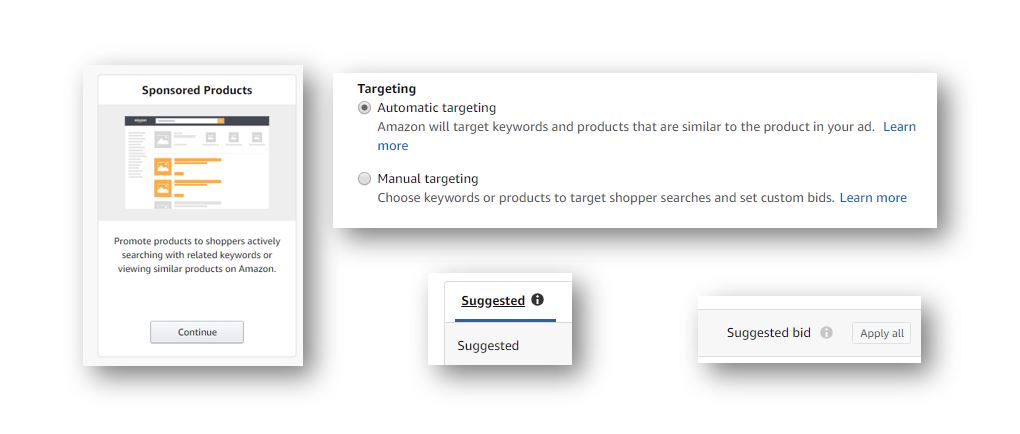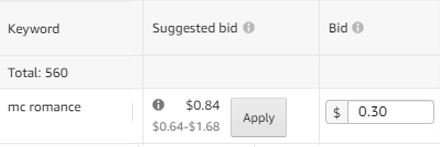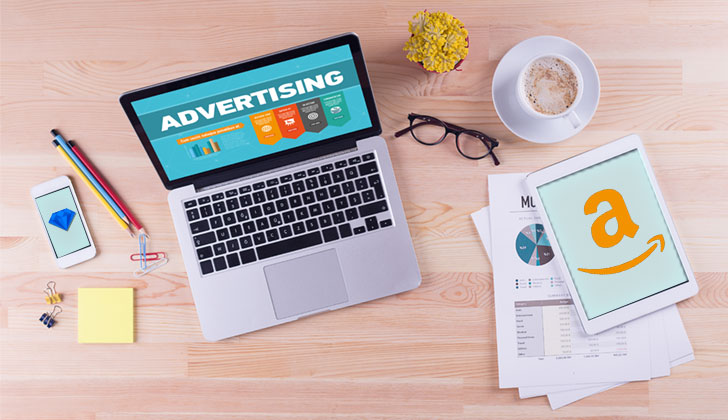Making Sense of Amazon Advertising
Amazon Advertising – until recently known as Amazon Marketing Services (AMS) – is an increasingly important part of any self-published author’s strategy but many authors are confused by how it works and how to interpret their results. Fortunately, Hidden Gems advertising expert Ginger is here to walk us through the basics – how to get started, what some common problems mean and how to solve them, and how to make it all work for you!
The ability to have your book displayed as a clickable link on the product page of similar authors – presented to Amazon customers already searching for books to read – is a game-changer. However, Amazon Advertising has a notoriously steep learning curve, and successful advertisers need to keep a constant eye on their campaigns. In this post, we’re going to try to answer some of the more common questions would-be advertisers have, and help translate the data Amazon provides you with so you can better understand the state of your advertising.
If you want to know how quickly and meaningfully Amazon Advertising has evolved, you need look no further than the Big Daddy of advertising for authors, Mark Dawson. Last year, when he launched his AMS Ads for Authors course (as part of his Advertising for Authors course) he dismissed the effectiveness of Amazon ads, and his ad spend reflected that.
Flash forward twelve months, and Dawson is offering brand new, fully-revamped course material – reflecting the massive improvements Amazon has made to the program. The fact that Mark Dawson has also upped his own personal ad-spend – by over 1,000%, no less – demonstrates how effective Amazon Ads now have the potential to be.
That being said, Amazon Advertising has a notoriously steep learning curve – so we’ve listened to some of the many questions we receive about running ads on Amazon, and have put together this post as a way of answering them all at once.
Getting started running Amazon advertising
If you’re a complete newbie to advertising, the whole Amazon Advertising dashboard can be a bit daunting. The good news is – it used to be even worse! Amazon has been honing down what works and what doesn’t, and trying to provide potential advertisers with the most effective tools possible.
At the moment there are two types of advertising available to authors – Sponsored Ads, and Lockscreen Ads. Sponsored Ads place your book as “Sponsored Content” in relevant search terms, and on the product pages of relevant books. Lockscreen Ads can leave your book as the wallpaper of a sleeping Kindle – so readers can access your product with just a tap of their finger as soon as they wake their device.
The easiest and arguably most effective place to get started is with Sponsored Ads – but they’re not as simple as they look. Amazon tries to make entry into advertising easy by automating a lot of the process – like selecting which products your books get featured alongside, and choosing what they think are effective keywords for you to use – but a lot of their suggestions are useless (to say the least)! For example, when I was trying to advertise my “bad-boy romance” book, Amazon suggested I bid fifty cents on the keyword “bad book”!

If you have money you’re willing to burn, you can certainly learn a lot from just playing around with Amazon Advertising – but I’d strongly recommend taking that money and investing it more strategically in some training to help you get to grips with all of the customization. Mark Dawson’s online course is certainly a fantastic place to start, if you have the time, money and focus to wade through his very well-developed instructional videos and worksheets. However, Hidden Gems offers 1-to-1 virtual coaching/consulting sessions on setting up and managing your ads, conducted over Skype or Google Hangouts, and if you need a more guided approach, you might find this extremely useful.
It’s worth taking the time to do this before you begin – as even with a low daily budget, advertising costs soon add up; and you want that money to work for you as much as you can make it.
Why Amazon Ads may not be spending any of your budget
When I first started running Amazon ads for my books, my biggest frustration wasn’t spending money and not getting sales – it was Amazon not spending any of my money at all! This is actually a frequent complaint that newbie advertisers have, and is related to the number and relevance of the targeting you use.
If you’re focusing on using keywords for advertising, you have to understand that Amazon can only offer your book up as “Sponsored Content” for that keyword if somebody is actually searching for that keyword. The fewer keywords you have – and the more niche they are – the fewer people will be searching for those keywords on any given day. This limits the opportunities for Amazon to actually offer your book up to potential customers!
Compare these two results for keywords related to Motorcycle Club Romance books. Over the course of an 8-day period, the keyword “mc romance” has been searched for enough that this author’s book was offered to potential customers 3,483 times. The alternative keyword “mc boxed set” on the other hand has only given the author the opportunity to be displayed once!

This is why it always pays to target as many keywords as possible. Amazon will allow you to advertise up to 1,000 individual keywords, or keyword strings (for example, “mc romance” is two words, but only a single keyword) and don’t recommend running any keyword ads with fewer than 300 keywords. The more keywords you have, the more potential impressions you’ll get – and the more likely one of those will be to convert into a sale.
Unlocking the mystery of the keyword bidding process
The likelihood of your book being featured in the “Sponsored Content” section of keyword searches is related not just to how often people search for that individual keyword, but also how much you “bid” to have your book featured there.
This is another argument for using as many keywords as possible – especially if your book is likely to be featured in the “Sponsored Content” of highly competitive keywords.
Competitive keywords – as in, keywords that are frequently searched for, like “mc romance” above – can be a double-edged sword. On the one hand, it’s GREAT to have your book appearing in so many searches. However, it also means you’re bidding on a very general, and therefore very competitive, keyword. Other authors are eager to have their book featured in searches linked to these keywords as well – so in order to have your book featured in searches related to this term you’ll have to set your bid pretty high!
The way Amazon’s bidding process words is like this: Every keyword in your inventory has a figure next to it. You “bid” how much you’re willing to pay to have somebody click on your book when it appears in the “Sponsored Content” section for searches related to that term. If there are 10 spaces available to be featured as “Sponsored Content” for that keyword, Amazon will pick the ten authors with the highest bids. This maximizes their profit if/when a reader does click on one of those ads.

To have your book featured on a competitive keyword like “mc romance” you’ll have to be prepared to gamble on a higher bid than other authors. In this instance, Amazon has a suggested bid of up to $1.68 for each click on this keyword – showing that a lot of other authors are fighting to have their books shown during this search, and willing to pay well over a dollar for every click they receive on them. The author I work with is only willing to pay $0.30 per click – meaning their books are far less likely to be featured in the competitive “Sponsored Content” section, but when they are, each click will cost them a lot less.
Compare that to the other word we showed you: “mc boxed set”. That has a suggested bid of just $0.40 per click, meaning that because fewer readers are searching for this keyword, authors are bidding a lot less to be featured in “Sponsored Content” related to it – and your bid for each potential click will cost you less.
As an advertiser, your dilemma is trying to have your book featured in as many searches as possible, while at the same time keeping your Cost Per Click as low as possible – because you will only make your money back on that click if the reader then purchases your book.
For example – if your book retails on Amazon for $2.99, and you receive 70% of royalties for that sale, you’ll make $2.00 for every book you sell (the $0.09 difference is eaten up by costs.)
If somebody searches for the keyword “mc romance” and your bid is high enough for your book to be featured in the “Sponsored Content” related to that search, you’ll be charged whatever the “winning” bid is if anybody clicks on your ad. If you bid $1.60, for example, but all the other authors only bid $0.99 (or less), your “bid” will be $1.00 and that’s how much a click will cost you (your bid is more of a maximum, it doesn’t necessarily mean you’ll be charged that much).
In business terms – that means it costs you $1.00 to drive a potential reader to your product page. Now, here’s the important bit – if that reader then doesn’t click to buy your book, you just spent that money for nothing!
So, with a profit margin of just $2.00 to play with, you’ll eliminate any potential profit if you aren’t getting more than 1 out of every 2 clicks to “convert” into a customer, i.e. to buy your book.
If 1 out of 3 clicks ends up resulting in a sale, you’re losing $1.00 every time you make a sale!
Given that even the most successful advertisers and authors – like Mark Dawson himself – consider a 15% conversion rate (as in, 15 out of every 100 clicks results in a sale) to be at the higher end of what’s possible, you can see how quickly bidding on a competitive keyword can eat through your marketing budget!
So, the trick to succeeding with keywords is to find as many not-so-searched for keywords as possible, since the bid for them will be lower. It’s better to have 10 clicks on 10 different keywords, at $0.20 each, then 2 clicks on a highly competitive keyword at $1.00 each. If you are averaging a 10% conversion rate (as in, 1 click out of 10 translates to a sale) those 10 clicks will cost you $2.00 to translate to a sale (so you’d be breaking even) while the more competitive keyword will cost you $10 to sell one copy of your book (losing you $8.00 in the process.)
This is where the complicated stuff comes into play – as there are a lot of other factors to consider. Some keywords are more targeted, and will result in more clicks converting into sales. In those instance, it might be worth bidding more. Amazon helps you work this out with something called the ACOS percentage – “Average Cost Per Sale. ” The percentage is how much above or below the cost of your book you spend on acquiring a sale. Spending $2.99 on keyword clicks to sell a single copy of your book at $2.99, for example, would be an ACOS of 100%.
In truth, even this isn’t a fair figure. If you’re part of Kindle Select, you’ll receive 70% of the book’s royalties – so anything higher than a 70% ACOS means you’re losing money on book sales.
If your book is part of Kindle Unlimited, however, you might be receiving income in the form of page reads that isn’t reflected in your ACOS, which is calculated only using book sales. Amazon doesn’t provide this data directly to you, but in popular genres this means an ACOS of 300% or even 500% might still be making you money.
There are a lot of factors to consider here – which is why it’s often worth booking a 1-to-1 consult call with us to discuss your advertising before you begin, so you know exactly how to calculate the numbers you need to.
Why you may be getting lots of impressions, but no clicks
Impressions are the number of times your book is featured in the “Sponsored Content” section of searches relevant to your keywords. If you’re getting a lot of impressions, that’s great! Lots of people are seeing your book featured in “Sponsored Content” and you don’t pay for impressions!
If few or none of those impressions are resulting in a click, though – then you have a problem.
There are various factors that could be at play here – some potentially linked to your choice of keywords, but others could be due to the way your book is presented in the “Sponsored Content” section.
Keyword issues
If your keywords aren’t as relevant to your book as they need to be, Amazon won’t know the difference – so they’ll continue serving up your ads to this audience, even though many of the people who see your ad aren’t interested in clicking on it. This is a surprisingly common problem, especially with authors who use third-party tools to generate their keywords, as those are often very generic, acquired using an identical methodology, and there are no human pairs of eyes to offer a ‘sanity check’ before including them.
For example, I’ve seen children books aimed at 6 to 8-year-old kids featured in the “Sponsored Content” section of teenage fantasy novels, because parents of two or more kids – using the same Amazon account to purchase books for both of them – are inadvertently polluting the ‘”also bought” section of the teenage fantasy books with books purchased for their 7-year-old. This means if a tool is mindlessly pulling from your also bought list, some of the results may be completely wrong for your book.
This is where the value of doing your own research and hand-selecting keywords is so valuable – or finding somebody you trust to do it for you.
Your cover isn’t appealing
We’ve written before about how Amazon customers most definitely judge a book by its cover, and this is never more true than in advertising. Potential readers catch a glimpse of your book in the “Sponsored Content” section and if your cover isn’t compelling enough to make them click it, you’ll never get any follow through to your product page.
As I said above – if your keywords are directing your book to the wrong “Sponsored Keyword” sections, this might be the cause. If your cover doesn’t look like any of the books it’s featured alongside, there might be nothing wrong with it except that you’re showing it to the wrong audience.
But you have to be tough with yourself – and ask: “Is this cover really working?” If your book as had lackluster performance so far, you might have to accept that it’s not. Book covers are a MASSIVE part of the process of selling a book on Amazon, so you might have to accept that this is the roadblock.
Hidden Gems offers a holistic appraisal of your book in a 1-on-1 consult with a self-publishing expert, and we also offer an affordable cover design service with a couple of different designers you can choose from. If you’re thinking this might be the problem, we might be able to help.
There’s some issue with your ad
Aside from the first two problems, the only other explanation is that your book doesn’t seem “clickable” for some other reason. This might be because the advertising copy is bad, or your book has too few or no reviews (or the reviews are bad.) Although some of these reasons can be more holistic issues to do with your book, rather than a problem with your advertising, so it might be time to look at what could be turning readers off and addressing it.
Why you may be getting lots of clicks, but no sales
As an author, this is the worst situation to be in. What happens here is that your keywords are good and directing the right type of potential reader to your “Sponsored Content”, you’re getting plenty of impressions, your cover and ad copy are compelling enough for potential readers to want to click and learn more about your book, but…
…no one is buying.
You are suffering from “poor conversions” – as in, too few people who click on your ad are “converting” into paying customers.
The long and short of it is that conversions are everything in publishing. If you can’t get people to buy your book, all your other efforts are wasted. Even worse than that, you’re paying for those clicks, but you’re not getting any money back in sales. This is where a lot of authors give up, and abandon advertising altogether.
Well, don’t!
There is a silver lining to all this. Clearly the cover and the copy of your book is compelling enough for people to actually want to click on the advert initially. It’s only when they read your blurb, see your “Look Inside” section, or read the reviews that they have issues. The good news is that this is the most fixable of situations, as clearly there is some interest in your book, as demonstrated by those clicks.
Sometimes if you’re honest enough with yourself, or have a trusted and experienced colleague you can call on for help, you may be able to figure out the issue on your own and resolve it. If not, there are other places to turn to, such as booking a one hour call with one of our self-publishing experts here at Hidden Gems. We’ll examine your ads and product pages and then use our extensive experience and understanding of Amazon to help figure out what the problem is and come up with potential solutions to fix it.
At the end of the day, this is the part of the process that self-publishing success always boils down to – does anybody want to buy your book? It’s a tough nut to crack, but once you do, everything else about being a writer falls into place. As I said before – at least if you’ve come this far, you know there’s something about your book that people find interesting enough to click on.
The question left is how to get them to buy it!
We’ll be continuing to dig into the different challenges of marketing your book in future posts. In the meantime, if you have questions about advertising or self-publishing, or want to discuss booking a 1-on-1 call with us to go over your specific needs and issues, feel free to just send us an email and we’ll be happy to help!












2 Comments